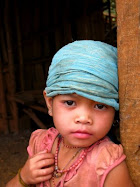Back in December, after researching some martial arts schools, I decided I would like to come back to China ‘someday’ to study the ancient Chinese art of Tai Ji Quan. Most commonly known to westerners as Tai Chi, this is a soft, or internal, martial art as opposed to hard, or external, martial arts like Karate, Kung Fu, or Tae Kwan Do. Movements are very relaxed, balanced, and usually slow, with mental focus on controlling internal energy in the body. You may have seen videos of older Chinese people doing this slow graceful exercise together in the park.
Yarrow and I discussed it and she encouraged me to stay in China another 2 months to improve my Chinese and study Tai Chi. Rather than hope that someday I’ll have time to come back, I should take the opportunity now, when I don’t have other commitments. I was hesitant to stay here as we would be apart for more than 2 months, and I would not get a chance to see any of Southeast Asia or Yarrow’s family in
In
I'm staying at
Sunset over the roof of the school.
Instructor Lao Li with Scott, another American Student. Master Fu's school is in the background.
We train two hours in the morning and two hours in the afternoon, six days a week. Meals at the school are mostly vegetarian and very healthy. Usually it even tastes good! The village is fairly quiet with beautiful scenery. From the rooftop training area you can see over two dozen karst limestone mountains. The beautiful view and peaceful surroundings were the main reason I chose this school over the others in the area. I met a Chinese guy, Cai Lei, who is living in the village and studying English. Before he went home for Chinese New Year, we were spending an hour or two every day reading to each other in English and Chinese. Those sessions really improved my Chinese pronunciation and Cai Lei got to learn the meaning of Americanisms like ‘slacking off’ and ‘getting the ax’. I can now converse in Chinese at a pretty basic level, but I still know very little and don’t understand a lot of what people say.
Training on a beautiful day as Andy takes in some sun.
In eight weeks of intensive training I’ve learned what would have taken a year or more studying back in the states. I first learned a short Chen 18 form and I just finished the 74 movement Chen Lao Jia Yi Lu form. It takes almost 15 minutes to do that form from beginning to end and requires a lot of concentration to stay relaxed and to remember which move comes next. I have also been working on a Yang style Tai Chi traditional 32 step form with a private teacher about five hours a week. Learning the forms is just the first level of Tai Chi skill. It takes years of practice to be able to do the forms while moving the energy correctly inside the body. There’s also the more advanced exercise of Push Hands where you hone your Tai Chi skills with a partner, trying to push each other off balance. I’ve studied several other martial arts in the past and Tai Chi seems to demand more precise movements and is very challenging to perform correctly.
Instructor Jason (left) and Eyal practicing Push Hands.
One thing that made the Tai Chi practice more difficult is that I chose to stay here at the same time as
In southern
Me, Lao Li and Scott on one of the few nice days this month.
Having practiced Tai Chi almost two months now, I notice improved posture, stronger legs, better flexibility, more relaxation, and people think I look years younger than I am. It must have something to do with the low stress lifestyle, exercise and healthy food. I plan to continue practicing on my own when I leave and hope to be able to come back here again someday. I’ve met a lot of neat people here and want to thank Andy and Gal for taking some photos for me to post on this blog. Living here has been an enjoyable experience that is coming too quickly to an end but I’m really looking forward to seeing Yarrow again and traveling





































